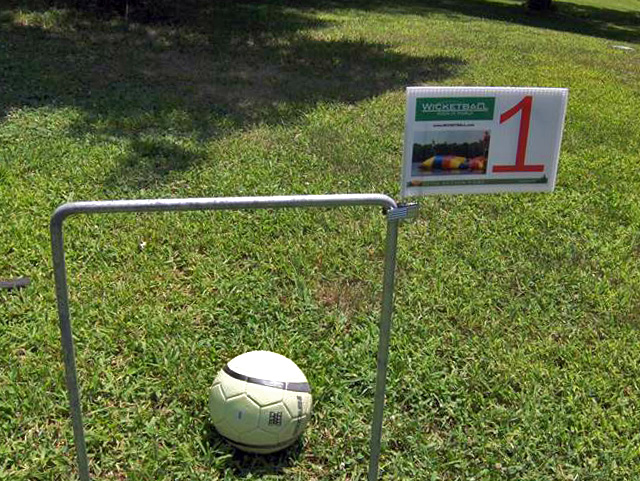Wicketball is a new sport invented by Bob Zoller from Lenexa, Kansas in 2000. Wicketball is like soccer croquet. Wicketball is an outdoor activity that can be enjoyed by all ages. It combines soccer skills and croquet strategy in a golf course layout. Wicketball is being played in at least 30 states and 8 countries.
 wicketball
wicketballEquipment Required: Wicketball wickets, wicket signs, #5 soccer balls
Sport Description
Wicketball can be played where ever there is outdoor space to put in the wickets: backyards, acreage properties, pastures, parks, sand beaches, wooded areas, office greenspace areas, etc.. The world is your Wicketball field... be creative! You can play on many outdoor surfaces: lawn, sand, dirt, fields, or snow. The more hills, trees, creeks, and hazards... the better... especially for competitive courses.
The wickets push in to play... and pull out to reset in a different area, or to bring them in when you're done. You have total flexibility in setting up the course depending on your skill level, number of players, ages, terrain difficulty, etc.
The object of Wicketball is to kick your ball completely through each wicket in as few kicks as possible, playing directly against other players. The official ball is a #5 soccer ball, but any type of ball can be used.
Rules & Guidelines
1. Each player kicks their own ball. In doubles, players can have their own ball or take turns kicking one ball. The ball must pass fully thru the current wicket, in the lowest number of kicks, to score 1 point. Players alternate taking turns kicking. More than one player can score the 1 point at each wicket.
2. If your ball is stopped and any portion is under the current wicket, you cannot score the point on that kick, or if the ball is hit thru. Your ball must be fully outside the wicket when it is kicked thru for you to score the 1 point. You must wait until your opponent's ball fully stops before taking your next kick.
3. The winner of the current wicket starts first for the next wicket. If more than one player won the current wicket, kick in the order that the 1 point was scored. The ball should be started for the next wicket anywhere in a 5 foot radius around the current wicket. The ball should be kicked by subsequent players in the same spot where the first player kicked from.
4. Do not touch or pick up your ball until the current wicket is completed by everyone. When the current wicket is completed, pick up your ball and get ready for the next wicket. Exception: Balls kicked out of bounds: streets, creeks, parking areas, etc. can be played from where they lay, OR picked up and set back in the field of play up to 3 feet. If you pick up your ball, you lose 1 kicking turn.
5. You can touch the ball with your toe/foot if you are flicking (lifting) it with your toe/foot. You must tell your opponent(s) that you are flicking the ball on your turn. You cannot "carry" the ball on your toe/foot to change the ball's direction. You can only use one foot to kick with each turn.
Rate this Sport
What do you think about this 'sport'? Please rate it on its potential.
Note
Related Pages
- See other New Sports
- about the sport of croquet
- Complete list of unusual sports
Disclaimer


 Current Events
Current Events